Genome-Wide Identification of WOX Genes in Korean Pine and Analysis of Expression Patterns and Properties of Transcription Factors
Simple Summary
Abstract
1. Introduction
2. Materials and Methods
2.1. Plant Material and Growth Conditions
2.2. Identification of PkWOX Family Genes in Korean Pine and Analysis of Physicochemical Properties
2.3. Chromosomal Localization, Collinearity Analysis, and Synteny Analysis
2.4. Multiple Sequence Alignment and Phylogenetic Analysis
2.5. Analyzing the Exon/Intron Structure and Conserved Motifs
2.6. Cis-Element Analysis of the PkWOX Promoters
2.7. GO Enrichment Analysis of the PkWOX Genes
2.8. Tissue-Specific Expression Patterns of the PkWOX Genes
2.9. Expression Patterns of PkWOX Genes Under Abiotic Stress
2.10. Cloning of the PkWOX Genes of Korean Pine
2.11. Subcellular Localization of PkWOXs
2.12. Yeast-Based Transcriptional Activity Assay
- (1)
- pGBKT7-PkWOX constructs;
- (2)
- Empty pGBKT7 vector (negative control).
- -
- SD/-Trp (Coolaber, Beijing, China) (transformation control);
- -
- SD/-Trp/-His/-Ade (Coolaber, Beijing, China) (activation stringency test);
- -
- X-α-Gal (WEIDI, Shanghai, China) plates (reporter activation assay).
2.13. Data Statistics and Analysis
3. Results
3.1. Genome-Wide Characterization and Physicochemical Profiling of the WOX Gene Family in Korean Pine
3.2. Phylogenetic Analysis of Multiple Species, Protein Sequence Alignment, and Conservative Motif Analysis of PkWOXs
3.3. Chromosomal Location, Collinearity Analysis, and Ka/Ks Calculation
3.4. Analysis of the Cis-Elements of the PkWOX Promoter
3.5. GO Enrichment Analysis of PkWOX
3.6. Tissue Expression Specificity and Abiotic Stress Expression Pattern
3.7. Subcellular Localization and Transcriptional Activity Assessment of Transcription Factors
3.8. Prediction of Protein Interaction Networks for PkWOX Genes
4. Discussion
4.1. Roles of WOX Transcription Factors in Plant Growth and Morphogenesis
4.2. Proteins Exhibit Canonical Transcription Factor Characteristics
4.3. Differential Expression Patterns of PkWOX Genes in Response to Environmental Stressors
5. Conclusions
Supplementary Materials
Author Contributions
Funding
Institutional Review Board Statement
Informed Consent Statement
Data Availability Statement
Acknowledgments
Conflicts of Interest
References
- Kamiya, N.; Nagasaki, H.; Morikami, A.; Sato, Y.; Matsuoka, M. Isolation and characterization of a rice WUSCHEL-type homeobox gene that is specifically expressed in the central cells of a quiescent center in the root apical meristem. Plant J. 2003, 35, 429–441. [Google Scholar] [CrossRef] [PubMed]
- Mukherjee, K.; Brocchieri, L.; Burglin, T.R. A Comprehensive Classification and Evolutionary Analysis of Plant Homeobox Genes. Mol. Biol. Evol. 2009, 26, 2775–2794. [Google Scholar] [CrossRef] [PubMed]
- Haecker, A.; Gross-Hardt, R.; Geiges, B.; Sarkar, A.; Breuninger, H.; Herrmann, M.; Laux, T. Expression dynamics of WOX genes mark cell fate decisions during early embryonic patterning in Arabidopsis thaliana. Development 2004, 131, 657–668. [Google Scholar] [CrossRef]
- van der Graaff, E.; Laux, T.; Rensing, S.A. The WUS homeobox-containing (WOX) protein family. Genome Biol. 2009, 10, 248. [Google Scholar] [CrossRef]
- Breuninger, H.; Rikirsch, E.; Hermann, M.; Ueda, M.; Laux, T. Differential expression of WOX genes mediates apical-basal axis formation in the Arabidopsis embryo. Dev. Cell 2008, 14, 867–876. [Google Scholar] [CrossRef]
- Schoof, H.; Lenhard, M.; Haecker, A.; Mayer, K.F.; Jurgens, G.; Laux, T. The stem cell population of Arabidopsis shoot meristems in maintained by a regulatory loop between the CLAVATA and WUSCHEL genes. Cell 2000, 100, 635–644. [Google Scholar] [CrossRef]
- Wu, X.L.; Dabi, T.; Weigel, D. Requirement of homeobox gene STIMPY/WOX9 for Arabidopsis meristem growth and maintenance. Curr. Biol. 2005, 15, 436–440. [Google Scholar] [CrossRef]
- Etchells, J.P.; Provost, C.M.; Mishra, L.; Turner, S.R. WOX4 and WOX14 act downstream of the PXY receptor kinase to regulate plant vascular proliferation independently of any role in vascular organisation. Development 2013, 140, 2224–2234. [Google Scholar] [CrossRef] [PubMed]
- Li, X.; Guo, C.; Pu, W.; Liu, W.; Zhang, Y.; Sun, N.; He, X.; Liu, C.; Xu, L.; Gao, J. Genome-wide identification and systemic analysis of WOX family genes in tobacco. Acta Tabacaria Sin. 2021, 27, 90–100. [Google Scholar] [CrossRef]
- Zhang, X.; Zong, J.; Liu, J.; Yin, J.; Zhang, D. Genome-Wide Analysis of WOX Gene Family in Rice, Sorghum, Maize, Arabidopsis and Poplar. J. Integr. Plant Biol. 2010, 52, 1016–1026. [Google Scholar] [CrossRef]
- Lu, Y.; Yang, W.; Zhao, L.; Liu, Z.; Zhang, Y. Genome-wide Identification and Analysis of WOX Family Genes in Gossypium hirsutum L. Acta Agric. Boreali-Sin. 2017, 32, 21–31. [Google Scholar]
- Gambino, G.; Minuto, M.; Boccacci, P.; Perrone, I.; Vallania, R.; Gribaudo, I. Characterization of expression dynamics of WOX homeodomain transcription factors during somatic embryogenesis in Vitis vinifera. J. Exp. Bot. 2011, 62, 1089–1101. [Google Scholar] [CrossRef] [PubMed]
- Long, X.; Zhang, J.; Wang, D.; Weng, Y.; Liu, S.; Li, M.; Hao, Z.; Cheng, T.; Shi, J.; Chen, J. Expression dynamics of WOX homeodomain transcription factors during somatic embryogenesis in Liriodendron hybrids. For. Res. 2023, 3, 15. [Google Scholar] [CrossRef] [PubMed]
- Shi, L.; Wang, K.; Du, L.; Song, Y.; Li, H.; Ye, X. Genome-Wide Identification and Expression Profiling Analysis of WOX Family Protein-Encoded Genes in Triticeae Species. Int. J. Mol. Sci. 2021, 22, 9325. [Google Scholar] [CrossRef]
- Alvarez, J.M.; Bueno, N.; Canas, R.A.; Avila, C.; Canovas, F.M.; Ordas, R.J. Analysis of the WUSCHEL-RELATED HOMEOBOX gene family in Pinus pinaster: New insights into the gene family evolution. Plant Physiol. Biochem. 2018, 123, 304–318. [Google Scholar] [CrossRef] [PubMed]
- Palovaara, J.; Hakman, I. Conifer WOX-related homeodomain transcription factors, developmental consideration and expression dynamic of WOX2 during Picea abies somatic embryogenesis. Plant Mol. Biol. 2008, 66, 533–549. [Google Scholar] [CrossRef]
- Xiao, Y.; Chen, Y.; Ding, Y.; Wu, J.; Wang, P.; Yu, Y.; Wei, X.; Wang, Y.; Zhang, C.; Li, F.; et al. Effects of GhWUS from upland cotton (Gossypium hirsutwn L.) on somatic embryogenesis and shoot regeneration. Plant Sci. 2018, 270, 157–165. [Google Scholar] [CrossRef]
- Nowak, K.; Moronczyk, J.; Grzyb, M.; Szczygiel-Sommer, A.; Gaj, M.D. miR172 Regulates WUS during Somatic Embryogenesis in Arabidopsis via AP2. Cells 2022, 11, 718. [Google Scholar] [CrossRef]
- Kong, D.; Hao, Y.; Cui, H. The WUSCHEL Related Homeobox Protein WOX7 Regulates the Sugar Response of Lateral Root Development in Arabidopsis thaliana. Mol. Plant 2016, 9, 261–270. [Google Scholar] [CrossRef]
- Hou, J.; Wu, Y.; Shen, Y.; Mao, Y.; Liu, W.; Zhao, W.; Mu, Y.; Li, M.; Yang, M.; Wu, L. Plant regeneration through somatic embryogenesis and shoot organogenesis from immature zygotic embryos of Sapium sebiferum Roxb. Sci. Hortic. 2015, 197, 218–225. [Google Scholar] [CrossRef]
- Hassani, S.B.; Trontin, J.-F.; Raschke, J.; Zoglauer, K.; Rupps, A. Constitutive Overexpression of a Conifer WOX2 Homolog Affects Somatic Embryo Development in Pinus pinaster and Promotes Somatic Embryogenesis and Organogenesis in Arabidopsis Seedlings. Front. Plant Sci. 2022, 13, 838421. [Google Scholar] [CrossRef]
- Nardmann, J.; Zimmermann, R.; Durantini, D.; Kranz, E.; Werr, W. WOX gene phylogeny in Poaceae: A comparative approach addressing leaf and embryo development. Mol. Biol. Evol. 2007, 24, 2474–2484. [Google Scholar] [CrossRef] [PubMed]
- Mayer, K.F.; Schoof, H.; Haecker, A.; Lenhard, M.; Jurgens, G.; Laux, T. Role of WUSCHEL in regulating stem cell fate in the Arabidopsis shoot meristem. Cell 1998, 95, 805–815. [Google Scholar] [CrossRef] [PubMed]
- Wang, D.; Qiu, Z.; Xu, T.; Yao, S.; Zhang, M.; Cheng, X.; Zhao, Y.; Ji, K. Identification and Expression Patterns of WOX Transcription Factors under Abiotic Stresses in Pinus massoniana. Int. J. Mol. Sci. 2024, 25, 1627. [Google Scholar] [CrossRef] [PubMed]
- Mao, Y.X.; Zhang, H.D.; Wang, R.Z.; Yan, T.W.; Wei, W.J.; You, W.Z. Spatial structure characteristics of the main tree species in a mixed broadleaved Korean pine (Pinus koraiensis) forest in a mountainous area of eastern Liaoning Province, China. Chin. J. Appl. Ecol. 2019, 30, 2933–2940. [Google Scholar] [CrossRef]
- Holt, A.L.; van Haperen, J.M.A.; Groot, E.P.; Laux, T. Signaling in shoot and flower meristems of Arabidopsis thaliana. Curr. Opin. Plant Biol. 2014, 17, 96–102. [Google Scholar] [CrossRef]
- Su, Y.H.; Zhao, X.Y.; Liu, Y.B.; Zhang, C.L.; O’Neill, S.D.; Zhang, X.S. Auxin-induced WUS expression is essential for embryonic stem cell renewal during somatic embryogenesis in Arabidopsis. Plant J. 2009, 59, 448–460. [Google Scholar] [CrossRef]
- Wang, F.X.; Shang, G.D.; Wu, L.Y.; Xu, Z.G.; Zhao, X.Y.; Wang, J.W. Chromatin Accessibility Dynamics and a Hierarchical Transcriptional Regulatory Network Structure for Plant Somatic Embryogenesis. Dev. Cell 2020, 54, 742–757.e8. [Google Scholar] [CrossRef]
- Potter, S.C.; Luciani, A.; Eddy, S.R.; Park, Y.; Lopez, R.; Finn, R.D. HMMER web server: 2018 update. Nucleic Acids Res. 2018, 46, W200–W204. [Google Scholar] [CrossRef]
- Wilkins, M.R.; Gasteiger, E.; Bairoch, A.; Sanchez, J.C.; Williams, K.L.; Appel, R.D.; Hochstrasser, D.F. Protein identification and analysis tools in the ExPASy server. Methods Mol. Biol. 1999, 112, 531–552. [Google Scholar]
- Thompson, J.D.; Gibson, T.J.; Plewniak, F.; Jeanmougin, F.; Higgins, D.G. The CLUSTAL_X windows interface: Flexible strategies for multiple sequence alignment aided by quality analysis tools. Nucleic Acids Res. 1997, 25, 4876–4882. [Google Scholar] [CrossRef] [PubMed]
- Kumar, S.; Stecher, G.; Tamura, K. MEGA7: Molecular Evolutionary Genetics Analysis Version 7.0 for Bigger Datasets. Mol. Biol. Evol. 2016, 33, 1870–1874. [Google Scholar] [CrossRef] [PubMed]
- Langmead, B.; Salzberg, S.L. Fast gapped-read alignment with Bowtie 2. Nat. Methods 2012, 9, 357–359. [Google Scholar] [CrossRef] [PubMed]
- Lescot, M.; Dehais, P.; Thijs, G.; Marchal, K.; Moreau, Y.; Van de Peer, Y.; Rouze, P.; Rombauts, S. PlantCARE, a database of plant cis-acting regulatory elements and a portal to tools for in silico analysis of promoter sequences. Nucleic Acids Res. 2002, 30, 325–327. [Google Scholar] [CrossRef]
- Liu, Y.Y.; Wei, M.J.; Hou, C.; Lu, T.T.; Liu, L.L.; Wei, H.R.; Cheng, Y.X.; Wei, Z.G. Functional Characterization of Populus PsnSHN2 in Coordinated Regulation of Secondary Wall Components in Tobacco. Sci. Rep. 2017, 7, 42. [Google Scholar] [CrossRef]
- Liu, J.; Hu, X.; Qin, P.; Prasad, K.; Hu, Y.; Xu, L. The WOX11-LBD16 Pathway Promotes Pluripotency Acquisition in Callus Cells During De Novo Shoot Regeneration in Tissue Culture. Plant Cell Physiol. 2018, 59, 734–743, Erratum in Plant Cell Physiol. 2018, 59, 876. [Google Scholar] [CrossRef] [PubMed]
- Zhao, Y.; Hu, Y.; Dai, M.; Huang, L.; Zhou, D.-X. The WUSCHEL-Related Homeobox Gene WOX11 is Required to Activate Shoot-Borne Crown Root Development in Rice. Plant Cell 2009, 21, 736–748. [Google Scholar] [CrossRef] [PubMed]
- Ji, J.; Strable, J.; Shimizu, R.; Koenig, D.; Sinha, N.; Scanlon, M.J. WOX4 Promotes Procambial Development. Plant Physiol. 2010, 152, 1346–1356. [Google Scholar] [CrossRef]
- Suer, S.; Agusti, J.; Sanchez, P.; Schwarz, M.; Greb, T. WOX4 Imparts Auxin Responsiveness to Cambium Cells in Arabidopsis. Plant Cell 2011, 23, 3247–3259. [Google Scholar] [CrossRef]
- Hirakawa, Y.; Kondo, Y.; Fukuda, H. TDIF Peptide Signaling Regulates Vascular Stem Cell Proliferation via the WOX4 Homeobox Gene in Arabidopsis. Plant Cell 2010, 22, 2618–2629. [Google Scholar] [CrossRef]
- Ditengou, F.A.; Tealea, W.D.; Kochersperger, P.; Flittner, K.A.; Kneuper, I.; van der Graaff, E.; Nziengui, H.; Pinosa, F.; Li, X.; Nitschke, R.; et al. Mechanical induction of lateral root initiation in Arabidopsis thaliana. Proc. Natl. Acad. Sci. USA 2008, 105, 18818–18823. [Google Scholar] [CrossRef] [PubMed]
- Wang, H.; Xie, Y.; Liu, W.; Tao, G.; Sun, C.; Sun, X.; Zhang, S. Transcription factor LkWOX4 is involved in adventitious root development in Larix kaempferi. Gene 2020, 758, 144942. [Google Scholar] [CrossRef] [PubMed]
- Tang, F.; Chen, N.; Zhao, M.; Wang, Y.; He, R.; Peng, X.; Shen, S. Identification and Functional Divergence Analysis of WOX Gene Family in Paper Mulberry. Int. J. Mol. Sci. 2017, 18, 1782. [Google Scholar] [CrossRef] [PubMed]
- Yoo, S.-C.; Cho, S.-H.; Paek, N.-C. Rice WUSCHEL-related homeobox 3A (OsWOX3A) modulates auxin-transport gene expression in lateral root and root hair development. Plant Signal. Behav. 2013, 8, e25929. [Google Scholar] [CrossRef]
- Pardo-Hernandez, M.; Arbona, V.; Simon, I.; Rivero, R.M. Specific ABA-independent tomato transcriptome reprogramming under abiotic stress combination. Plant J. 2024, 117, 1746–1763. [Google Scholar] [CrossRef]
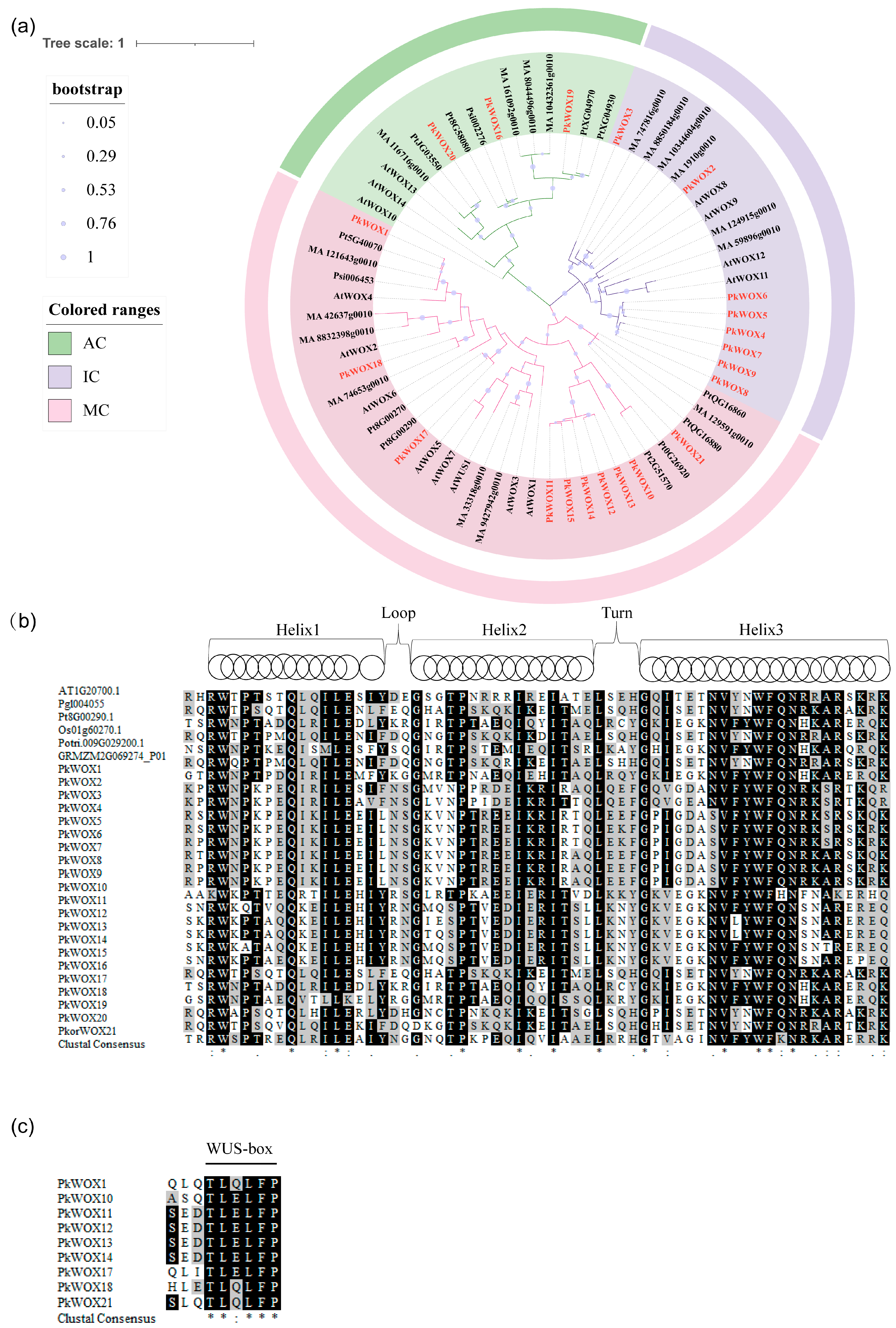
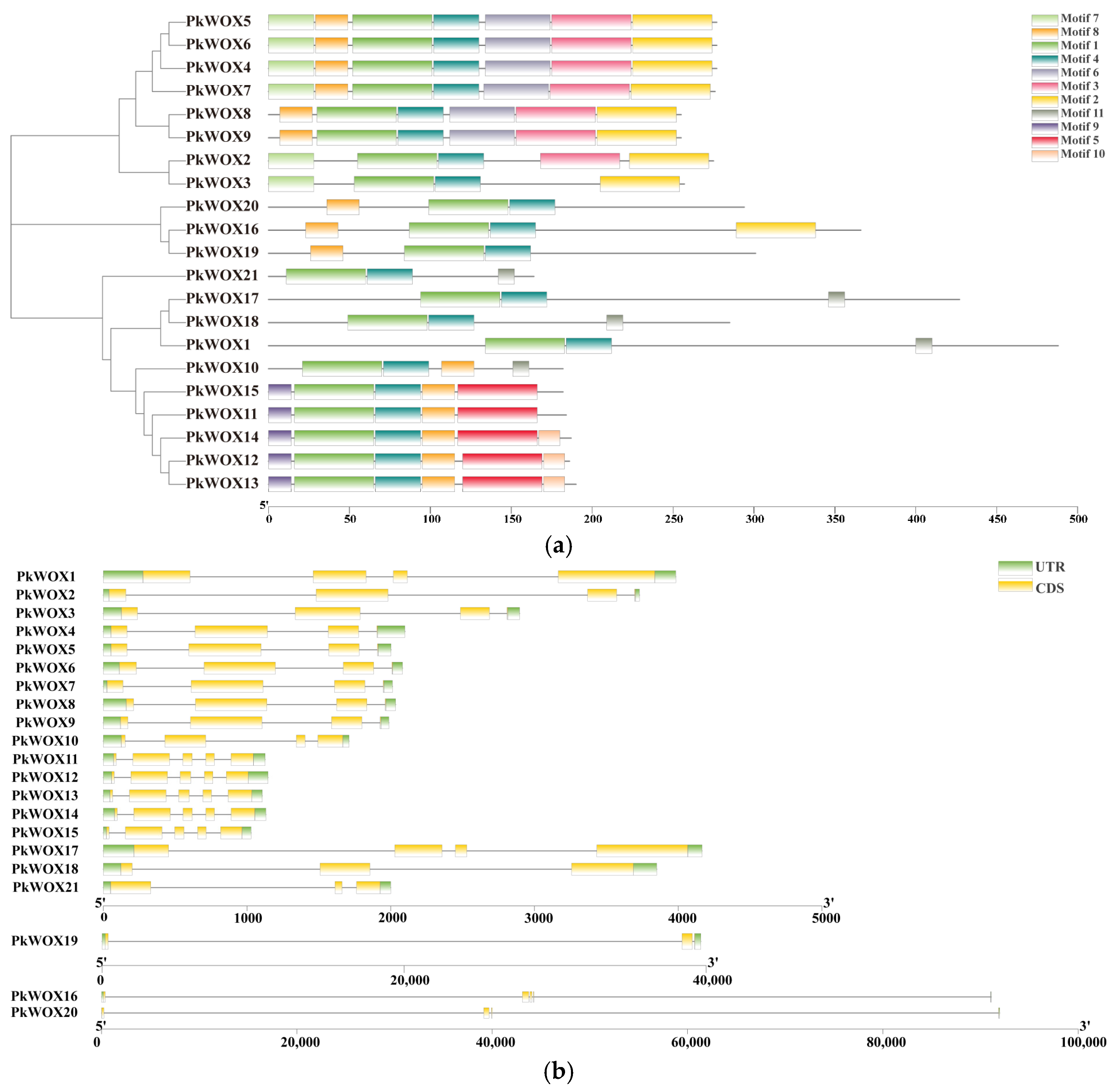
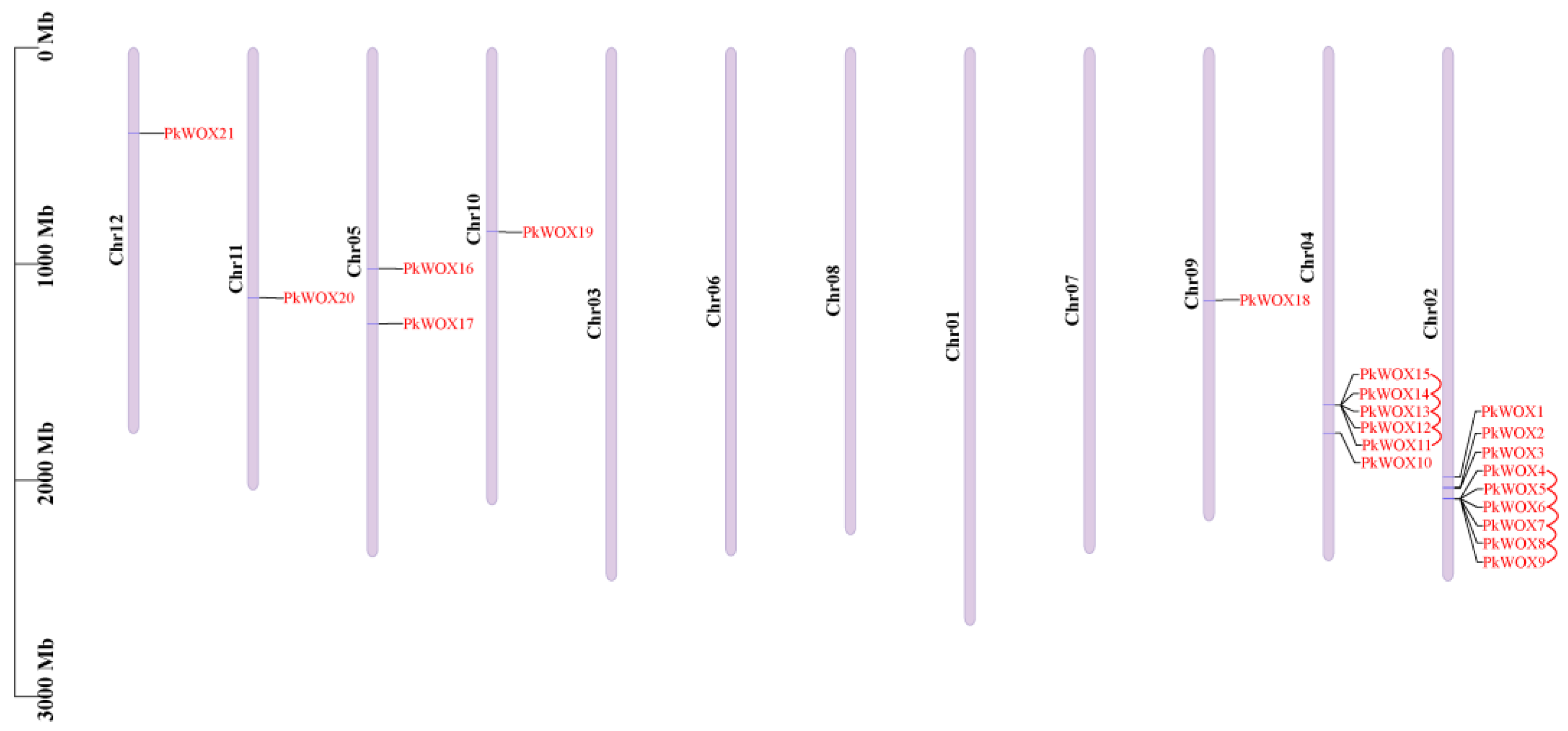

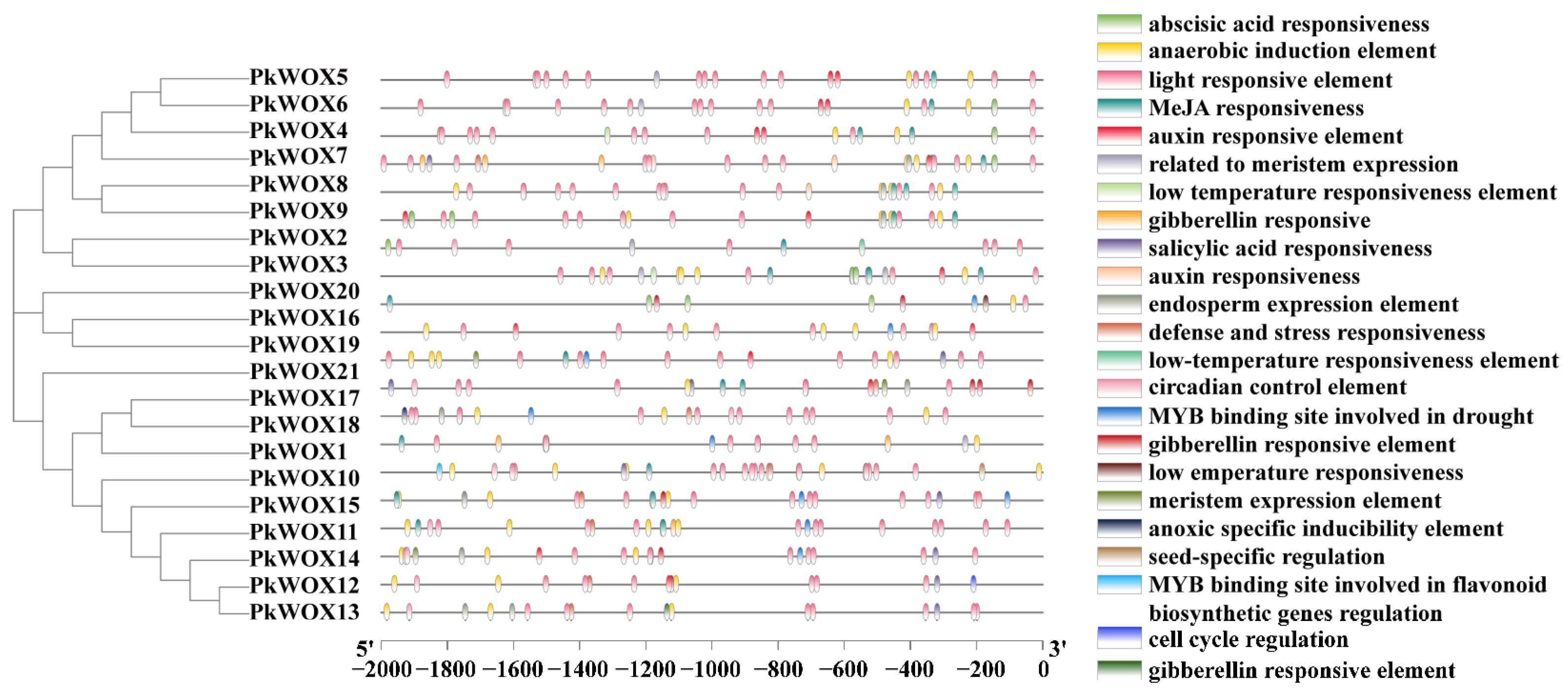
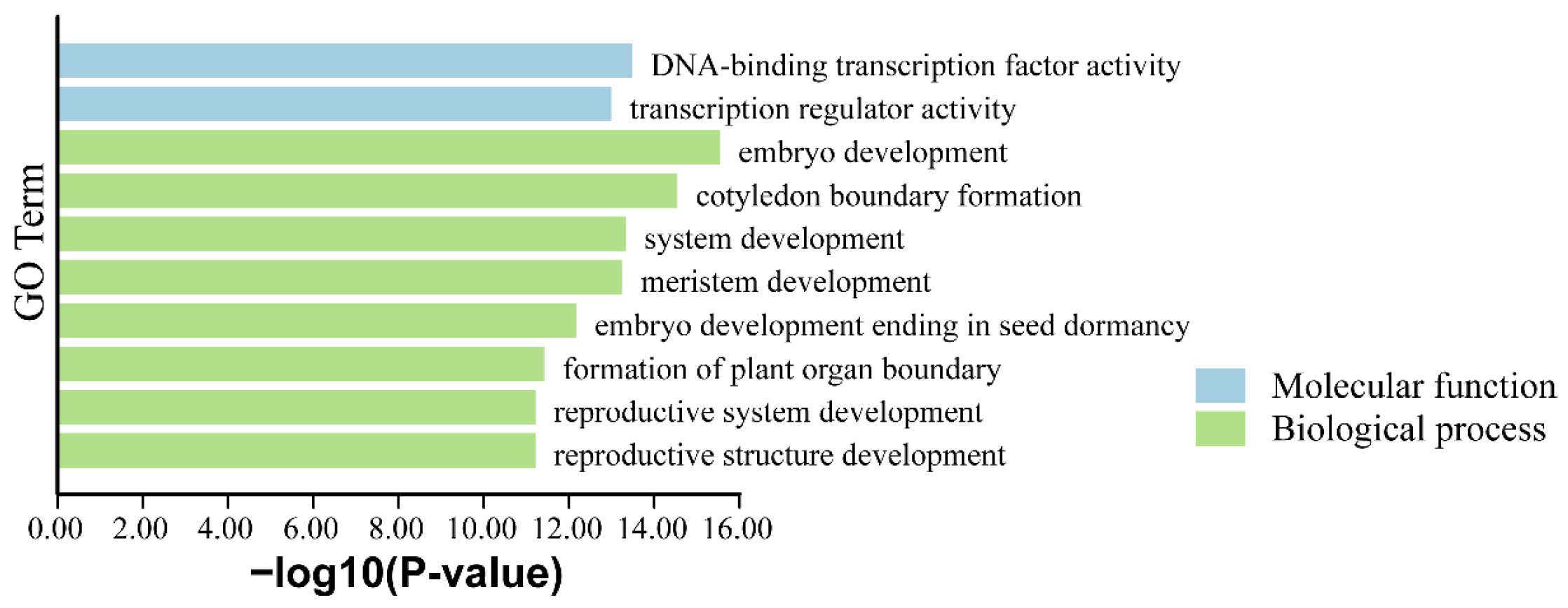

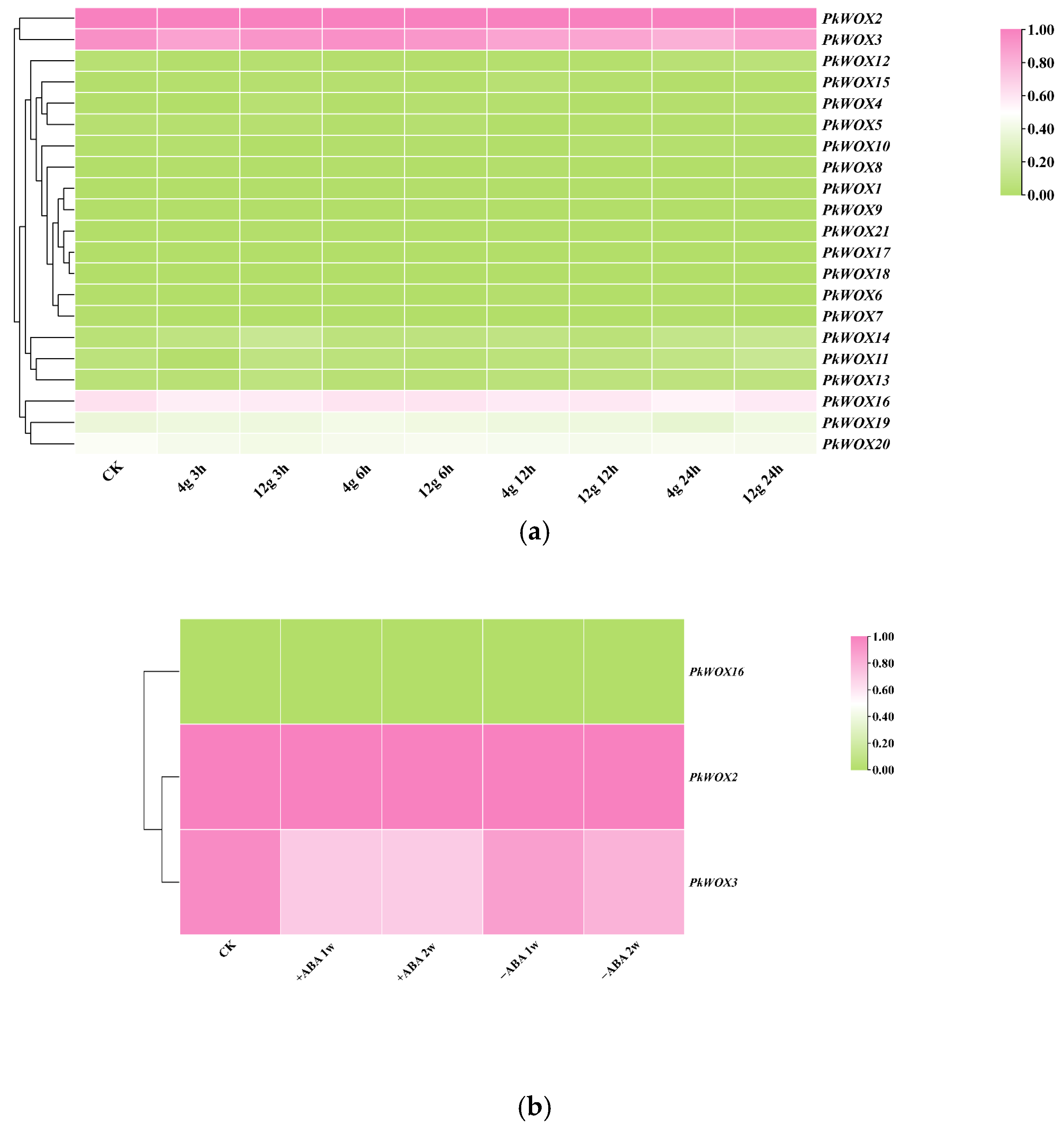
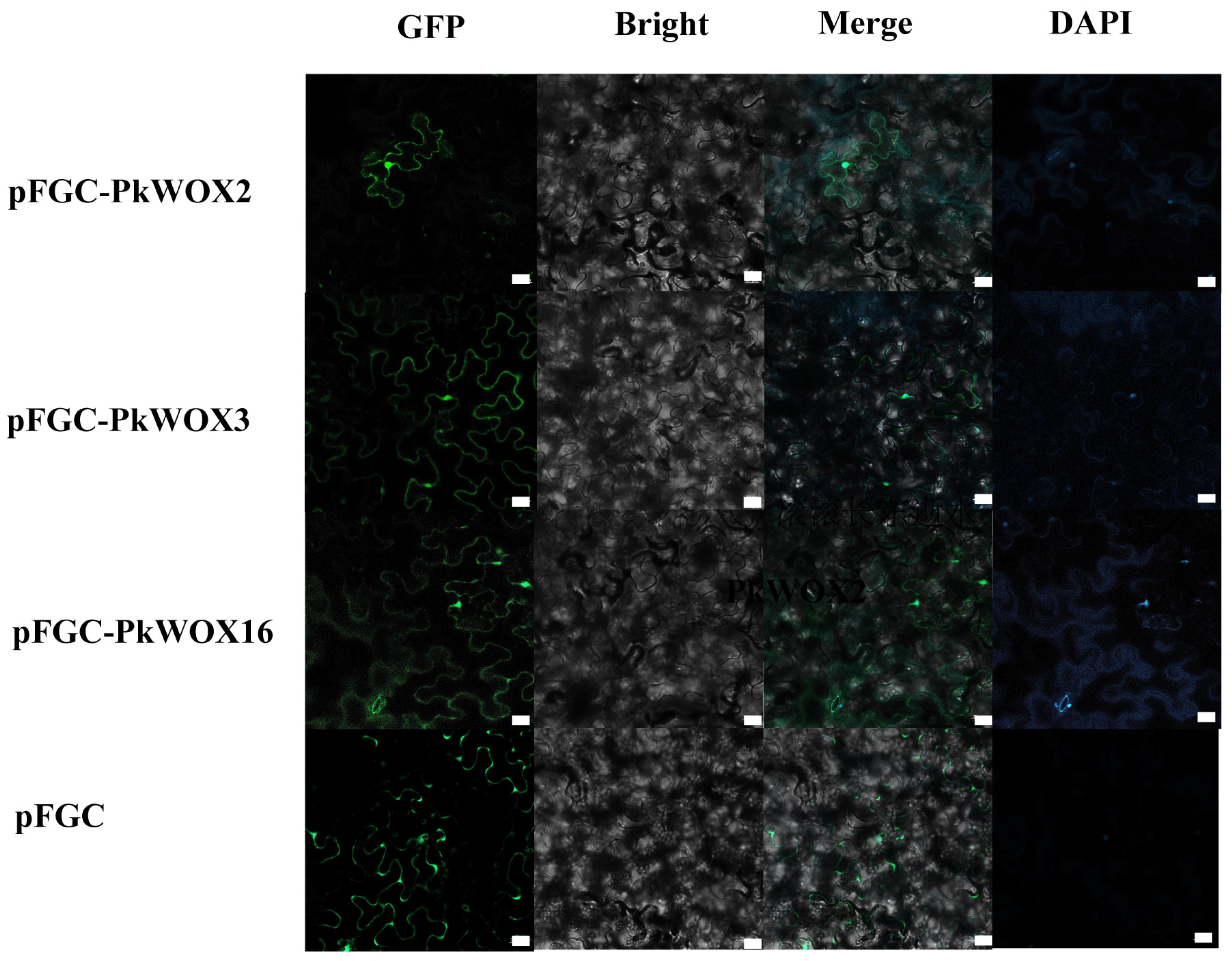
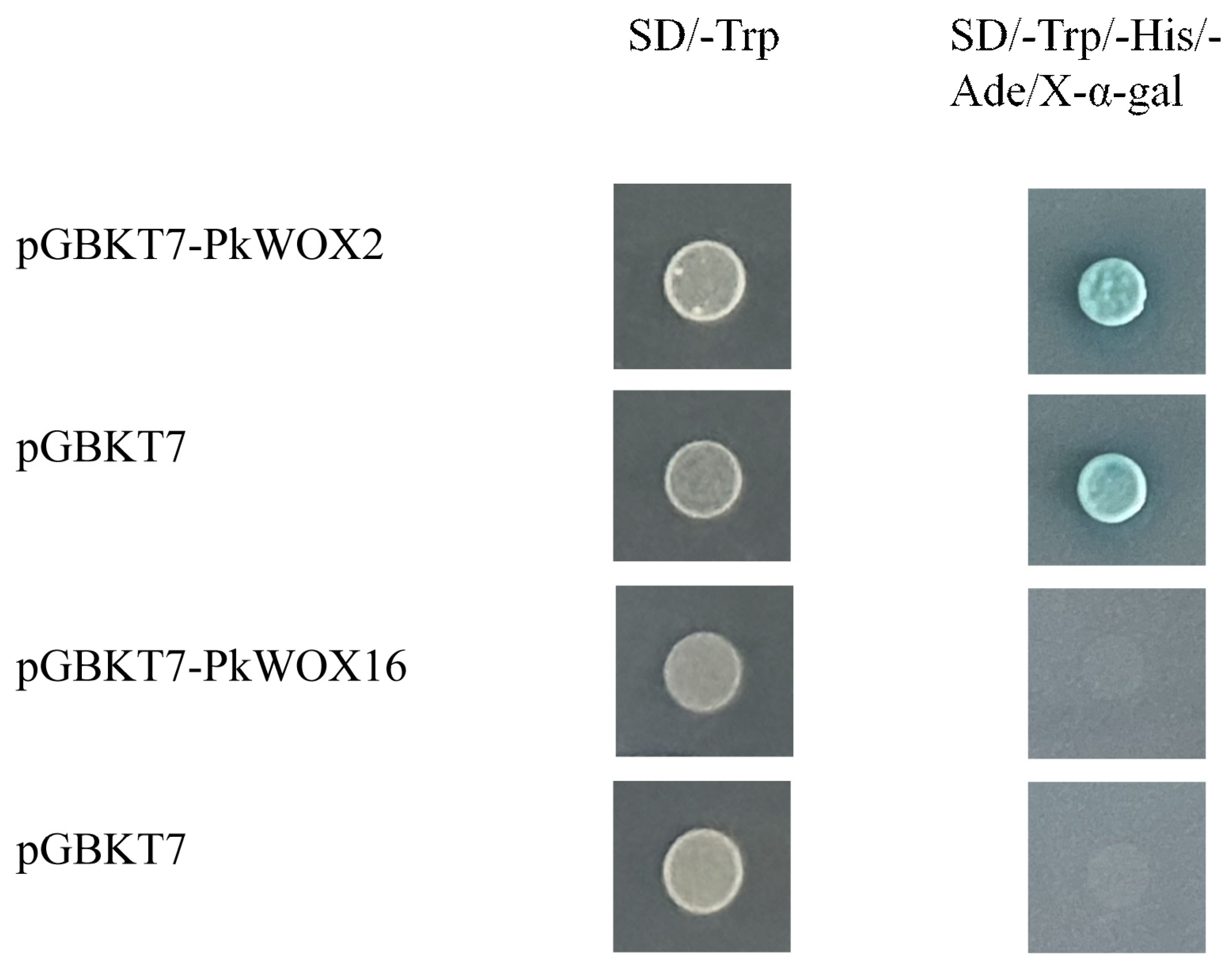
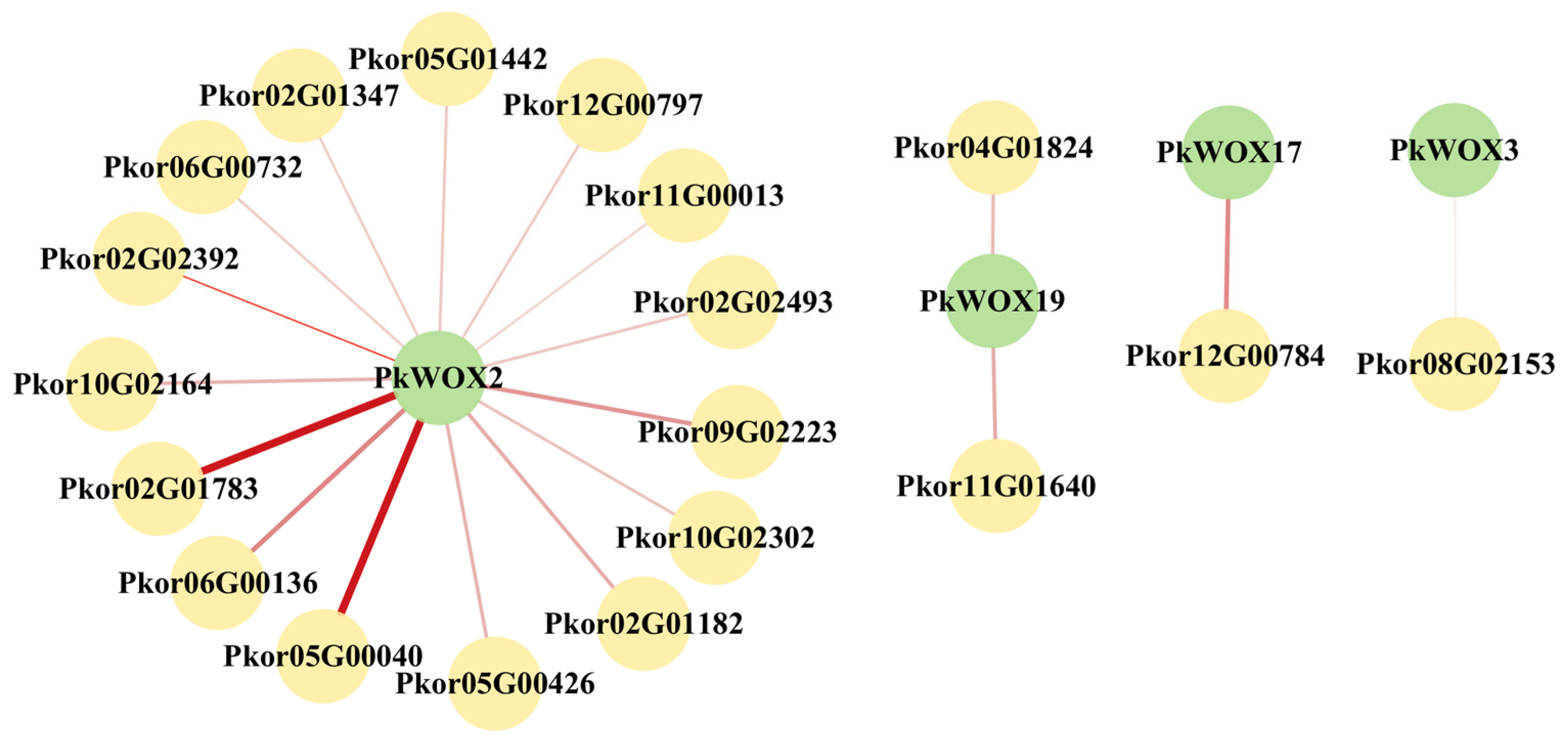
| Gene Name | Locus Name | Amino Acid No. | Molecular Weight (Da) | Isoelectric Points | GRAVY | Chromosome Location |
|---|---|---|---|---|---|---|
| PkWOX1 | Pkor02G02105 | 488 | 53893.18 | 6.61 | −0.665 | Chr02:1984412850..1984416411 |
| PkWOX2 | Pkor02G02159 | 275 | 30634.96 | 6.51 | −0.682 | Chr02:2032426825..2032430487 |
| PkWOX3 | Pkor02G02173 | 257 | 28472.43 | 6.06 | −0.658 | Chr02:2036932723..2036935410 |
| PkWOX4 | Pkor02G02661 | 277 | 30804.31 | 9.32 | −0.752 | Chr02:2084570897..2084572996 |
| PkWOX5 | Pkor02G02662 | 277 | 30806.36 | 9.56 | −0.793 | Chr02:2084651843..2084653845 |
| PkWOX6 | Pkor02G02663 | 277 | 30802.28 | 9.28 | −0.791 | Chr02:2084820524..2084822606 |
| PkWOX7 | Pkor02G02664 | 276 | 30820.43 | 9.47 | −0.788 | Chr02:2084926777..2084928789 |
| PkWOX8 | Pkor02G02665 | 255 | 28645.47 | 9.80 | −0.565 | Chr02:2085544487..2085546521 |
| PkWOX9 | Pkor02G02666 | 255 | 28670.47 | 9.72 | −0.571 | Chr02:2085656072..2085658059 |
| PkWOX10 | Pkor04G04148 | 182 | 21119.85 | 9.74 | −0.903 | Chr04:1787036381..1787038091 |
| PkWOX11 | Pkor04G04174 | 184 | 20798.41 | 9.52 | −0.753 | Chr04:1657982908..1657984034 |
| PkWOX12 | Pkor04G04175 | 186 | 20842.42 | 9.01 | −0.744 | Chr04:1657880486..1657881632 |
| PkWOX13 | Pkor04G04176 | 190 | 21186.68 | 9.15 | −0.793 | Chr04:1657819107..1657820213 |
| PkWOX14 | Pkor04G04177 | 187 | 21104.68 | 9.12 | −0.775 | Chr04:1657803316..1657804447 |
| PkWOX15 | Pkor04G04178 | 182 | 20565.93 | 7.73 | −0.782 | Chr04:1657787946..1657788974 |
| PkWOX16 | Pkor05G01247 | 360 | 40306.97 | 5.96 | −0.790 | Chr05:1020056105..1020146943 |
| PkWOX17 | Pkor05G01580 | 427 | 48231.86 | 7.65 | −0.761 | Chr05:1275855869..1275859721 |
| PkWOX18 | Pkor09G01265 | 285 | 32205.45 | 5.56 | −0.836 | Chr09:1166586641..1166590206 |
| PkWOX19 | Pkor10G00929 | 301 | 34200.94 | 7.21 | −0.993 | Chr10:852352721..852392372 |
| PkWOX20 | Pkor11G03014 | 294 | 32964.98 | 5.57 | −0.601 | Chr11:1155597034..1155688998 |
| PkWOX21 | Pkor12G02237 | 164 | 18456.30 | 5.83 | −0.729 | Chr12:395821012..395823012 |
Disclaimer/Publisher’s Note: The statements, opinions and data contained in all publications are solely those of the individual author(s) and contributor(s) and not of MDPI and/or the editor(s). MDPI and/or the editor(s) disclaim responsibility for any injury to people or property resulting from any ideas, methods, instructions or products referred to in the content. |
© 2025 by the authors. Licensee MDPI, Basel, Switzerland. This article is an open access article distributed under the terms and conditions of the Creative Commons Attribution (CC BY) license (https://creativecommons.org/licenses/by/4.0/).
Share and Cite
Zhang, Q.; Xu, X.; Yang, L. Genome-Wide Identification of WOX Genes in Korean Pine and Analysis of Expression Patterns and Properties of Transcription Factors. Biology 2025, 14, 411. https://doi.org/10.3390/biology14040411
Zhang Q, Xu X, Yang L. Genome-Wide Identification of WOX Genes in Korean Pine and Analysis of Expression Patterns and Properties of Transcription Factors. Biology. 2025; 14(4):411. https://doi.org/10.3390/biology14040411
Chicago/Turabian StyleZhang, Qun, Xiuyue Xu, and Ling Yang. 2025. "Genome-Wide Identification of WOX Genes in Korean Pine and Analysis of Expression Patterns and Properties of Transcription Factors" Biology 14, no. 4: 411. https://doi.org/10.3390/biology14040411
APA StyleZhang, Q., Xu, X., & Yang, L. (2025). Genome-Wide Identification of WOX Genes in Korean Pine and Analysis of Expression Patterns and Properties of Transcription Factors. Biology, 14(4), 411. https://doi.org/10.3390/biology14040411






